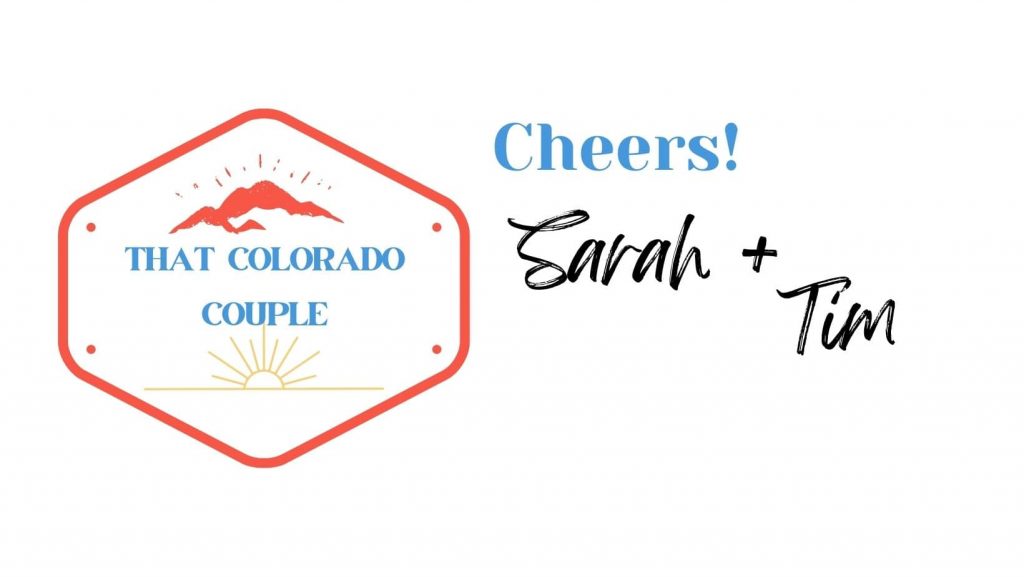Ultimate Local’s Guide to Bear Lake Road Corridor
The Bear Lake Road Corridor may be the most popular destination in all of Colorado’s Rocky Mountain National Park and for good reason. This 10.5-mile stretch of road winding from near the Beaver Meadows Entrance Station to Bear Lake Trailhead contains many of the best hikes and scenic views in the park. Whether you’re looking for a challenge at Sky Pond or a leisurely stroll around subalpine Bear Lake, this corridor offers something for every visitor to RMNP.
In this guide, we’ve pulled together everything you need to know about EVERY stop and pull-out on the Bear Lake Road corridor. Trust us, you won’t find a more detailed guide to this section of the park ANYWHERE else on the internet. From how to get timed-entry permits to which stops are worth your while and which are skippable, we cover it all.


How to get to Bear Lake Road Corridor
Bear Lake Road is 0.2 miles past the Beaver Meadows Entrance Station to Rocky Mountain National Park, just 4 miles from downtown Estes Park. Unless you live in Colorado, chances are you will be flying into Colorado via the Denver Airport. We recommend renting a car in Colorado so you have the most flexibility in how you spend your time. While there are various shuttle and public transportation options in Colorado, they don’t cover everywhere you’d want to go. A rental car is pretty much a must.
From the Denver Airport, it’s just an hour and a half drive (76 miles) to Estes Park, which is the best town to base yourself in for exploring Rocky Mountain National Park.
Where to Stay When Visiting Bear Lake Road
There are a ton of good accommodation options for any budget in Estes Park. Here are our recommendations:

Luxury
Midrange
- The Historic Crag’s Lodge
- Silver Moon Hotel
- Best Western Plus Silver Saddle Inn
- 4 Seasons Inn on Fall River
- Hotel Estes
Budget
Click here to search for additional hotels in Estes Park or search below!
Rocky Mountain National Park Entrance Information
The closest RMNP entrance to the Bear Lake Road corridor is the Beaver Meadows entrance outside Estes Park. All visitors need to pay $30 per vehicle for one-day admission (or $35 for 7 days). Alternatively, if you have an annual national park pass like America the Beautiful Pass, you won’t need to pay any extra for the park entrance. We get an annual park pass every year and it is for sure the best way to enter the park since it pays for itself if you plan on visiting 3 or more parks in a 12-month period.

Timed Entry Permits
In addition to the RMNP entrance fee, you will also need to obtain a timed-entry permit to enter the park between May and October. There are two different timed-entry permits for Rocky Mountain National Park: a permit that gives access to every part of the park EXCEPT Bear Lake Road, and a permit that includes access to everywhere in the park including Bear Lake Road. To get access to Bear Lake Road, you need to obtain Option 1 when you go to book your timed-entry permit on recreation.gov.
If you aren’t successful in getting a timed entry permit, you can still enter the park and Bear Lake Road between May and October without one IF you can arrive before 5 am or after 6 pm. Arriving after 6 pm does not give you much daylight time to fully explore Bear Lake Road, so we recommend getting up early to arrive prior to 5 am. Bonus incentive – sunrise at Bear Lake is beautiful!
Destinations on Bear Lake Road
Driving the 10.5 miles of Bear Lake Road, you’ll ascend from 7840 feet elevation to 9475 feet. It’s an incredibly scenic drive through Rocky Mountain National Park and showcases some of the most spectacular scenery in all of Colorado. There are many worthwhile stops along the way to where the road ends at Bear Lake. Here is everything you need to know about each of the destinations you can visit on Rocky Mountain National Park’s Bear Lake Road!
Moraine Park
Elevation: 8140 feet
Moraine Park gets its name from the two ridges that run alongside the plain. These ridges are called “moraines”, which means they are the rocks and rubble left over from Ice Age glacier movement and melting. While glaciers don’t currently cover Moraine Park, thousands of years ago, glaciers carved out this flat plain that is now a perfect haven for some of Rocky Mountain National Park’s iconic elk, springtime wildflowers, and expansive views of the mountain peaks.

What to do at Moraine Park
Whether you have a few minutes or a few days to spend at Moraine Park, there is something for everyone. Even if you just stop for a quick view of the mountains, a visit to Moraine Park on your drive along Bear Lake Road is well worth the time! Here are the main activities you can do from Moraine Park if you have more time to linger!
Hiking Trails in Moraine Park
Some of the most beautiful, and secluded, hikes in Rocky Mountain National Park start at Moraine Park. Here is a rundown of the trails you can hike here:
| Trail | Description | Distance (Round Trip) | Elevation Gain |
| Moraine Park Loop | A great trail for spotting elk and deer and wildflowers in the summer | 3.4 miles | 357 feet |
| South Lateral Moraine Trail | The trail goes through the forest along the edge of Moraine Park and is great for spotting elk, especially in the fall | 4.6 miles | 275 feet |
| Cub Lake | Great mountain views along the trail and at Cub Lake reward you on this pleasant pine wood forest trail | 5.6 miles | 715 feet |
| The Pool | Out and back trail to a small pond known as The Pool | 3.3 miles | 259 feet |
| Fern Falls | Waterfall hike with mountain views | 5 miles | 741 feet |
| Fern Lake | Continuation of the trail to The Pool and Fern Falls that leads to Fern Lake, a lovely subalpine lake surrounded by mountain scenery | 7.5 miles | 1476 feet |
| Spruce Lake | A little less than one mile past Fern Lake, you can reach Spruce Lake, though the trail is much rougher past Fern Lake | 8.7 miles | 1755 feet |
| Odessa Lake | Stunning lake with mountain views past Fern Lake on a trail opposite the trail to Spruce Lake | 9.3 miles | 1978 feet |
| Ute Trail | Challenging trail with a significant elevation gain from Beaver Meadows to tundra and on to Trail Ridge Road at 11500 feet above sea level | 12.7 miles | 3592 feet |
| Upper Beaver Meadows Trail | An easy stroll through the meadows and suitable for most ages and abilities | 1.1 miles | 114 feet |
Backpacking from Moraine Park
With so many hiking trails, many of which long and challenging, accessible from Moraine Park, it’s a great base from which to start a backpacking trip into the wilderness. Note that permits are required for overnight camping in the backcountry. You can get these permits in the park offices.
Camping at the Moraine Park Campground
For those who want to spend a night at Moraine Park but not backpack, you can stay at the Moraine Park Campground, which is the largest of the front country campgrounds in Rocky Mountain National Park. From mid-May to mid-September, reservations are recommended since this campground is very popular. From mid-September to mid-May, camping is available on a first-come, first-served basis. The campground sits at 8150 feet of elevation above sea level with stunning views of the meadows and a forest canopy. You can reserve a Moraine Park Campground spot 6 months in advance for $20 per night.
Moraine Park Museum and Discovery Center
The Moraine Park Discovery Center sits at the base of Eagle Cliff Mountain. The museum has educational exhibits on wildlife and geology of Moraine Park. The museum is housed in a historic building that was originally a lodge for visitors in the area’s early tourism days.
Fishing in Moraine Park
Those who enjoy fishing can catch trout in the Big Thompson River that flows through Moraine Park.
Horseback Riding in Moraine Park
Those who enjoy exploring on horseback can do so on the trails in Moraine Park. Exploring by horse, you may see elk, bighorn sheep, deer, or even coyote.

Tuxedo and Glacier Basin Picnic Areas
Elevation: 8120 feet
Shortly after Moraine Park on Bear Lake Road are two separate but close-by picnic areas. Both are serene places to enjoy a snack, but note there are no facilities (like trash or toilets) at either!
Hollowell Park
Elevation: 8300 feet
Hollowell Park is a quiet and serene spot with several picnic tables and great views of Mill Creek Basin nestled below towering Longs Peak, the tallest mountain in Rocky Mountain National Park, and one of Colorado’s iconic 14ers (mountains over 14,000 feet tall). From the parking lot, it’s a short trail to the picnic area. There are pit toilets available, but no trash receptacles, so it’s critical that you pack out all of your trash!
If you’re up for a hike, there are several permutations of trails that connect to the Hollowell Park Trail. One popular route is to connect Hollowell Park to the Mill Creek Basin Loop, which clocks in at 4.1 miles and 698 feet of elevation gain.
Bear Lake Road Park and Ride Lot
Elevation: 8600 feet
The next landmark after Hollowell Park is the Park and Ride lot. During the summer, buses run every 15 minutes between this lot and Bear Lake, making it a good option when parking is full at Bear Lake trailhead (which it frequently is). This free shuttle makes stops at Bierstadt Lake Trailhead, Glacier Gorge Trailhead, and Bear Lake.
Glacier Basin Campground
Elevation: 8500 feet
The 73 tent sites at Glacier Basin Campground are available by reservation only and only during the summer season. Sites are $30 per night and can be booked in advance on recreation.gov.
Hi Country Stables
Elevation: 8688 feet
The Hi Country Stables are the only horse stables located within Rocky Mountain National Park. You can book horseback riding tours ranging from 2 to 5 hours. All tours also include a timed-entry permit to the Bear Lake Corridor, which can make this a good option for a full day of exploring the destinations on Bear Lake Road in addition to your horseback ride. Tours run during the summer season from May to September.
Sprague Lake
Elevation: 8690 feet
Sprague Lake is an underrated stop on Bear Lake Road. There are several picnic tables here, including metal fire pits, as well as bathroom facilities. The short hike around Sprague Lake is great for most abilities and ages and features spectacular views of the mountains that make up the Continental Divide in RMNP. Read more about Sprague Lake in our comprehensive guide that covers everything you need to know!
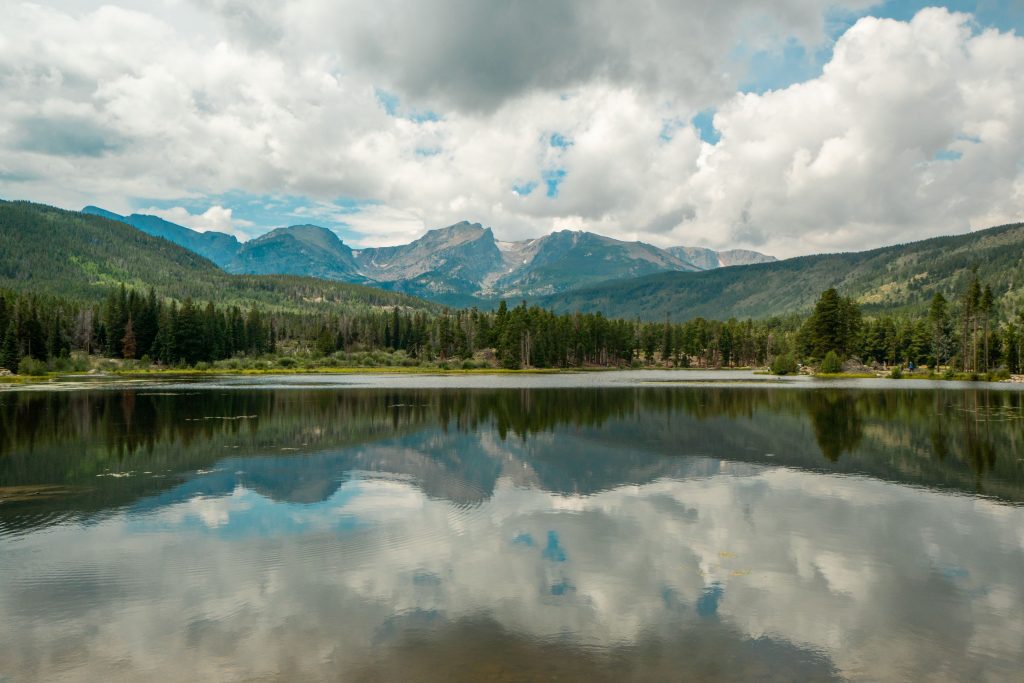
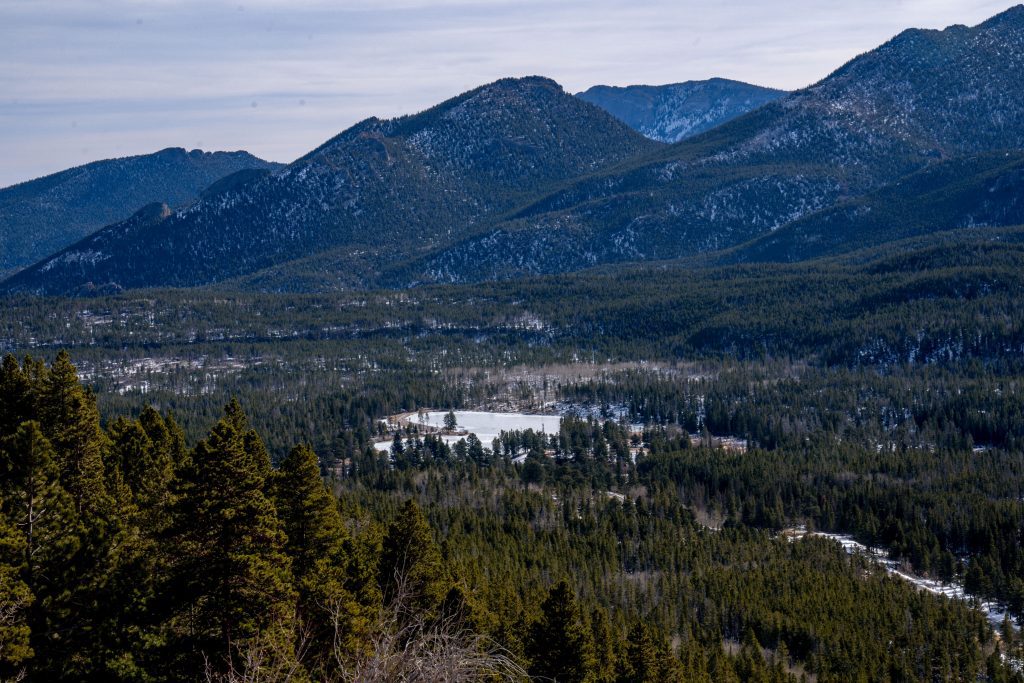
Storm Pass Trailhead
Elevation: 8800 feet
The next stop along Bear Lake Road is the parking area for the Storm Pass Trailhead. The Storm Pass hike is an all-day affair, covering 14.4 miles and gaining 3238 feet of elevation gain.
Bierstadt Lake Trailhead
Elevation: 8850 feet
An underrated hike in Rocky Mountain National Park, Bierstadt Lake is worth the steep ascent up the Bierstadt Moraine from the parking lot to the lake itself. While you can hike to Bierstadt Lake from the Bear Lake trailhead (and you may have to if there is no parking in the small lot at Bierstadt Lake Trailhead), we recommend hiking from here to get views of the mountains and even Sprague Lake in the distance as you climb your way up to Bierstadt Lake. You can read more about the hike to Bierstadt Lake, including the option of hiking from Bear Lake trailhead, in our comprehensive blog post.

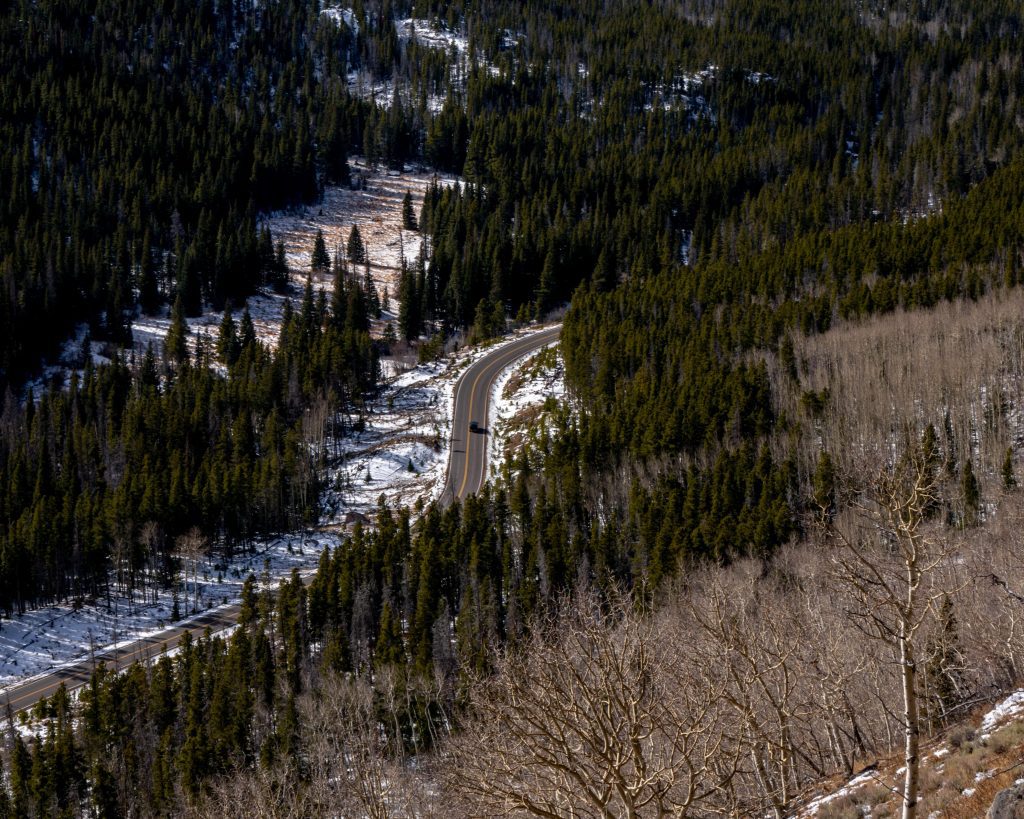
Prospect Canyon
Elevation: 9000 feet
The pullout for Prospect Canyon features an overlook of a ravine on Glacier Creek. Frankly, you can skip this stop unless you just want a reason to stretch your legs.
Glacier Gorge Trailhead
Elevation: 9240 feet
The parking lot at the Glacier Gorge Trailhead is second only to the Bear Lake Trailhead in terms of busyness and popularity. Glacier Gorge is a hub for several of the most popular hikes in all of Rocky Mountain National Park, including the same hikes accessed via Bear Lake Trailhead. Most people who park at Glacier Gorge are hiking to Alberta Falls, Loch Vale, or Sky Pond, though you can also hike to Lake Haiyaha, Emerald Lake, and many others from here. Click the links in this paragraph for our detailed hiking guides to each of those destinations. For more hiking options from Glacier Gorge Trailhead, see the table below.
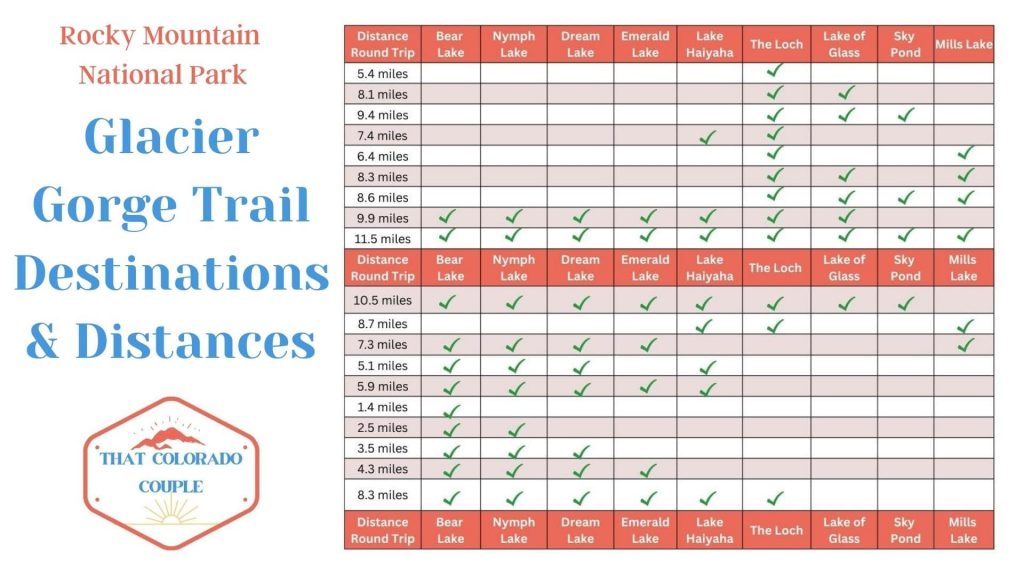



Bear Lake Trailhead
Elevation: 9475 feet
The Bear Lake Trailhead and parking area is the last stop on Bear Lake Road and is probably one of the busiest (if not THE busiest) locations in all of Rocky Mountain National Park. A major hub for many popular hikes, including the short and wheelchair-accessible Bear Lake Loop, the parking lot here fills up quickly in the summer months. Thankfully the free shuttle system and other lots like Glacier Gorge and Bierstadt Lake help offset the crowds somewhat. Still, we recommend getting to the Bear Lake Trailhead parking area before 9 am for your best chances of getting a spot.
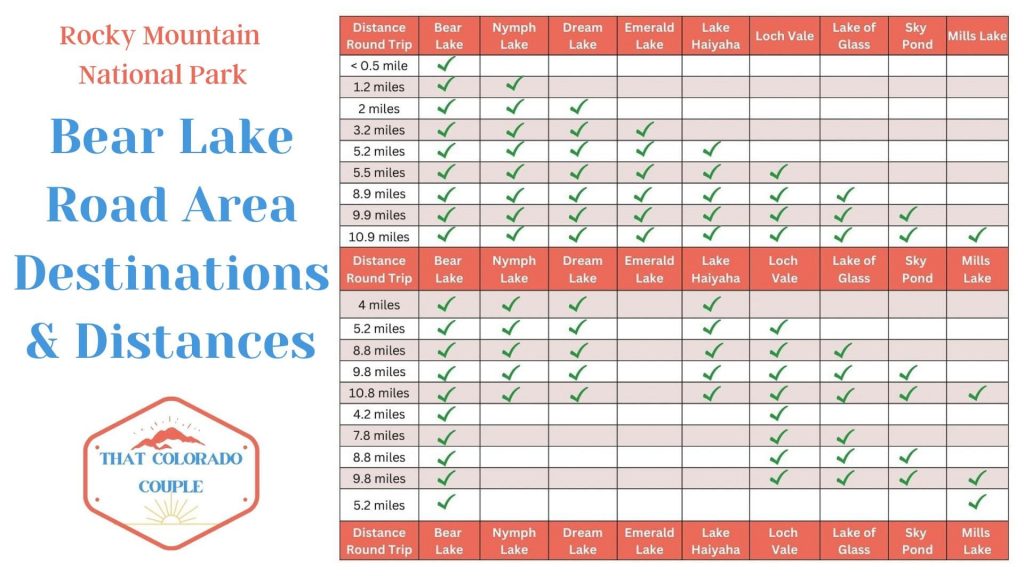
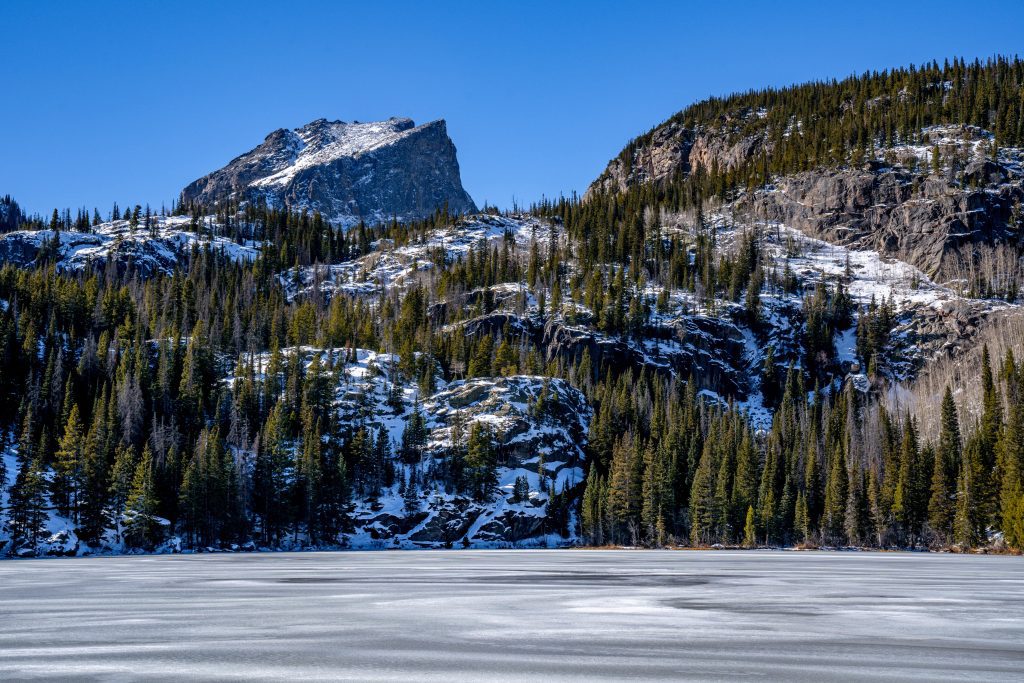
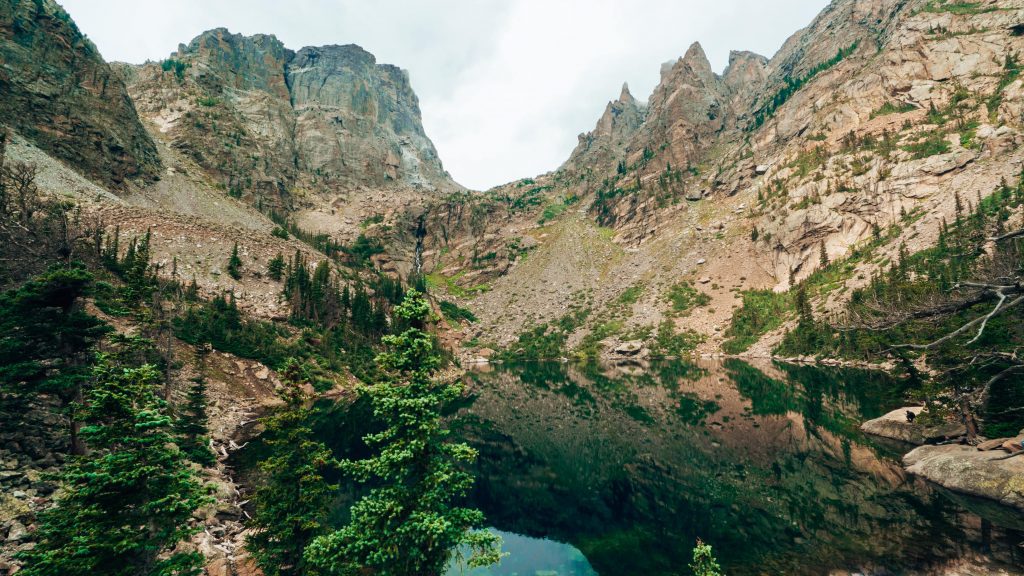


Local Tip
If we only had one day to spend in Rocky Mountain National Park, we’d drive straight to Bear Lake and hike to Emerald Lake and Lake Haiyaha before driving back down Bear Lake Road and making some of the scenic stops on the way out in the afternoon.
Map of Bear Lake Road Corridor
The below map shows every location mentioned in this post!
What to Bring and Wear to Bear Lake Road
- First and foremost, make sure you have a full tank of gas. Fill up in Estes Park before you enter RMNP as there are no gas stations inside the park!
- A jug of water to stay hydrated during the drive, or a hydration pack (like the Osprey Skimmer 20 for women or Osprey Talon 22 Pack for men) with a water bladder if you plan on hiking. Sarah always carries a gallon jug on road trips, and when hiking, wears a hydration pack with a 2-liter reservoir
- Snacks and lots of them! We always have Clif Energy Bars on hand in the car. They are great for the go because of the balanced mix of carbs, fats, and protein to keep us energized.
- A first aid kit is a must on any road trip or hike. Keep it in your car or carry it in your backpack
- Sun protection is key in the mountains where the sun is much stronger. We use Sun Bum – it’s our favorite sunscreen brand.
- Layers, layers, layers! The weather can change quickly and unpredictably in the mountains. I (Sarah) usually have a pullover, temperature-moderating wool t-shirts, and my Columbia jacket so I can layer and de-layer as needed throughout the day.
- If you plan on hiking, I recommend Columbia hiking boots and Tim loves his Foxelli boots. You can buy my hiking boots here. Don’t forget good socks, too. I’ve been wearing these double-layer Wrightsock brand socks for years and swear they are the best for preventing blisters.
- Don’t forget your camera! I use my Sony a7iii to document our adventures.

Final Thoughts on Driving Bear Lake Road
The Bear Lake Road corridor is one of THE best things to do in Rocky Mountain National Park. This iconic scenic drive offers stunning mountain views and access to some of the most popular hikes in the entire park.
If you’re planning to explore Rocky Mountain National Park, don’t miss our other RMNP guides to help you make the most of your trip to this spectacular part of Colorado!
